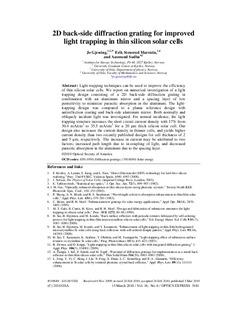| dc.description.abstract | Light-trapping techniques can be used to improve the efficiency of thin silicon solar cells. We report on numerical investigation of a light trapping design consisting of a 2D back-side diffraction grating in combination with an aluminum mirror and a spacing layer of low permittivity to minimize parasitic absorption in the aluminum. The light-trapping design was compared to a planar reference design with anti-reflection coating and back-side aluminum mirror. Both normally and obliquely incident light was investigated. For normal incidence, the light trapping structure increases the short circuit current density with 17% from 30.4 mA/cm^2 to 35.5 mA/cm^2 for a 20 µm thick silicon solar cell. Our design also increases the current density in thinner cells, and yields higher current density than two recently published designs for cell thickness of 2 and 5 µm, respectively. The increase in current may be attributed to two factors; increased path length due to in-coupling of light, and decreased parasitic absorption in the aluminum due to the spacing layer. | nb_NO |
